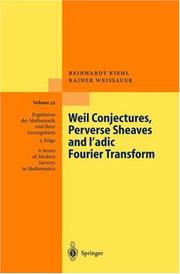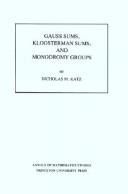| Listing 1 - 4 of 4 |
Sort by
|

ISBN: 3540414576 3642074723 3662045761 Year: 2001 Volume: 42 Publisher: Berlin Springer
Abstract | Keywords | Export | Availability | Bookmark
 Loading...
Loading...Choose an application
- Reference Manager
- EndNote
- RefWorks (Direct export to RefWorks)
In this book the authors describe the important generalization of the original Weil conjectures, as given by P. Deligne in his fundamental paper "La conjecture de Weil II". The authors follow the important and beautiful methods of Laumon and Brylinski which lead to a simplification of Deligne's theory. Deligne's work is closely related to the sheaf theoretic theory of perverse sheaves. In this framework Deligne's results on global weights and his notion of purity of complexes obtain a satisfactory and final form. Therefore the authors include the complete theory of middle perverse sheaves. In this part, the l-adic Fourier transform is introduced as a technique providing natural and simple proofs. To round things off, there are three chapters with significant applications of these theories.
Bundeltheorie --- Cohomology [Sheaf ] --- Faisceaux [Théorie des ] --- Homologie --- Homology theory --- Sheaf cohomology --- Sheaf theory --- Sheaves (Algebraic topology) --- Sheaves [Theory of ] --- Théorie des faisceaux --- Weil conjectures --- Weil conjectures. --- Homology theory. --- Sheaf theory. --- 512.73 --- Cohomology, Sheaf --- Sheaves, Theory of --- Algebraic topology --- Cohomology theory --- Contrahomology theory --- Conjecture, Weil's --- Conjectures, Weil --- Tate conjectures, Weil --- -Weil-Tate conjectures --- Weil's conjecture --- Geometry, Algebraic --- Cohomology theory of algebraic varieties and schemes --- 512.73 Cohomology theory of algebraic varieties and schemes --- Théorie des faisceaux --- Algebraic geometry. --- Group theory. --- K-theory. --- Algebraic Geometry. --- Group Theory and Generalizations. --- K-Theory. --- Groups, Theory of --- Substitutions (Mathematics) --- Algebra --- Algebraic geometry --- Geometry
Book
ISBN: 0691184437 Year: 2019 Publisher: Princeton, NJ : Princeton University Press,
Abstract | Keywords | Export | Availability | Bookmark
 Loading...
Loading...Choose an application
- Reference Manager
- EndNote
- RefWorks (Direct export to RefWorks)
A central concern of number theory is the study of local-to-global principles, which describe the behavior of a global field K in terms of the behavior of various completions of K. This book looks at a specific example of a local-to-global principle: Weil's conjecture on the Tamagawa number of a semisimple algebraic group G over K. In the case where K is the function field of an algebraic curve X, this conjecture counts the number of G-bundles on X (global information) in terms of the reduction of G at the points of X (local information). The goal of this book is to give a conceptual proof of Weil's conjecture, based on the geometry of the moduli stack of G-bundles. Inspired by ideas from algebraic topology, it introduces a theory of factorization homology in the setting ℓ-adic sheaves. Using this theory, Dennis Gaitsgory and Jacob Lurie articulate a different local-to-global principle: a product formula that expresses the cohomology of the moduli stack of G-bundles (a global object) as a tensor product of local factors.Using a version of the Grothendieck-Lefschetz trace formula, Gaitsgory and Lurie show that this product formula implies Weil's conjecture. The proof of the product formula will appear in a sequel volume.
Weil conjectures. --- Conjecture, Weil's --- Conjectures, Weil --- Tate conjectures, Weil --- -Weil-Tate conjectures --- Weil's conjecture --- Geometry, Algebraic --- Frobenius automorphism. --- G-bundles. --- Grothendieck–Lefschetz. --- Weil's conjecture. --- Weill's conjecture. --- affine group. --- algebraic geometry. --- algebraic topology. --- analogue. --- cohomology. --- continuous Künneth decomposition. --- factorization homology. --- function fields. --- global "ient stacks. --- infinity. --- local-to-global principle. --- moduli stack. --- number theory. --- rational functions. --- sheaves. --- trace formula. --- triangulated category.

ISBN: 0691084335 0691084327 1400882125 Year: 1988 Volume: vol 116 Publisher: Princeton, N.J. Princeton University
Abstract | Keywords | Export | Availability | Bookmark
 Loading...
Loading...Choose an application
- Reference Manager
- EndNote
- RefWorks (Direct export to RefWorks)
The study of exponential sums over finite fields, begun by Gauss nearly two centuries ago, has been completely transformed in recent years by advances in algebraic geometry, culminating in Deligne's work on the Weil Conjectures. It now appears as a very attractive mixture of algebraic geometry, representation theory, and the sheaf-theoretic incarnations of such standard constructions of classical analysis as convolution and Fourier transform. The book is simultaneously an account of some of these ideas, techniques, and results, and an account of their application to concrete equidistribution questions concerning Kloosterman sums and Gauss sums.
Group theory --- Algebraic geometry --- Number theory --- 511.33 --- Analytical and multiplicative number theory. Asymptotics. Sieves etc. --- 511.33 Analytical and multiplicative number theory. Asymptotics. Sieves etc. --- Gaussian sums --- Homology theory --- Kloosterman sums --- Monodromy groups --- Kloostermann sums --- Sums, Kloosterman --- Sums, Kloostermann --- Exponential sums --- Cohomology theory --- Contrahomology theory --- Algebraic topology --- Gauss sums --- Sums, Gaussian --- Analytical and multiplicative number theory. Asymptotics. Sieves etc --- Gaussian sums. --- Kloosterman sums. --- Homology theory. --- Monodromy groups. --- Number theory. --- Nombres, Théorie des. --- Exponential sums. --- Sommes exponentielles. --- Arithmetic --- Arithmétique --- Geometry, Algebraic. --- Géométrie algébrique --- Abelian category. --- Absolute Galois group. --- Absolute value. --- Additive group. --- Adjoint representation. --- Affine variety. --- Algebraic group. --- Automorphic form. --- Automorphism. --- Big O notation. --- Cartan subalgebra. --- Characteristic polynomial. --- Classification theorem. --- Coefficient. --- Cohomology. --- Cokernel. --- Combination. --- Commutator. --- Compactification (mathematics). --- Complex Lie group. --- Complex number. --- Conjugacy class. --- Continuous function. --- Convolution theorem. --- Convolution. --- Determinant. --- Diagonal matrix. --- Dimension (vector space). --- Direct sum. --- Dual basis. --- Eigenvalues and eigenvectors. --- Empty set. --- Endomorphism. --- Equidistribution theorem. --- Estimation. --- Exactness. --- Existential quantification. --- Exponential sum. --- Exterior algebra. --- Faithful representation. --- Finite field. --- Finite group. --- Four-dimensional space. --- Frobenius endomorphism. --- Fundamental group. --- Fundamental representation. --- Galois group. --- Gauss sum. --- Homomorphism. --- Integer. --- Irreducibility (mathematics). --- Isomorphism class. --- Kloosterman sum. --- L-function. --- Leray spectral sequence. --- Lie algebra. --- Lie theory. --- Maximal compact subgroup. --- Method of moments (statistics). --- Monodromy theorem. --- Monodromy. --- Morphism. --- Multiplicative group. --- Natural number. --- Nilpotent. --- Open problem. --- P-group. --- Pairing. --- Parameter space. --- Parameter. --- Partially ordered set. --- Perfect field. --- Point at infinity. --- Polynomial ring. --- Prime number. --- Quotient group. --- Representation ring. --- Representation theory. --- Residue field. --- Riemann hypothesis. --- Root of unity. --- Sheaf (mathematics). --- Simple Lie group. --- Skew-symmetric matrix. --- Smooth morphism. --- Special case. --- Spin representation. --- Subgroup. --- Support (mathematics). --- Symmetric matrix. --- Symplectic group. --- Symplectic vector space. --- Tensor product. --- Theorem. --- Trace (linear algebra). --- Trivial representation. --- Variable (mathematics). --- Weil conjectures. --- Weyl character formula. --- Zariski topology.
Book
ISBN: 069108288X 1400881498 Year: 1982 Publisher: Princeton (N.J.): Princeton university press
Abstract | Keywords | Export | Availability | Bookmark
 Loading...
Loading...Choose an application
- Reference Manager
- EndNote
- RefWorks (Direct export to RefWorks)
This book presents a coherent account of the current status of etale homotopy theory, a topological theory introduced into abstract algebraic geometry by M. Artin and B. Mazur. Eric M. Friedlander presents many of his own applications of this theory to algebraic topology, finite Chevalley groups, and algebraic geometry. Of particular interest are the discussions concerning the Adams Conjecture, K-theories of finite fields, and Poincare duality. Because these applications have required repeated modifications of the original formulation of etale homotopy theory, the author provides a new treatment of the foundations which is more general and more precise than previous versions.One purpose of this book is to offer the basic techniques and results of etale homotopy theory to topologists and algebraic geometers who may then apply the theory in their own work. With a view to such future applications, the author has introduced a number of new constructions (function complexes, relative homology and cohomology, generalized cohomology) which have immediately proved applicable to algebraic K-theory.
Algebraic topology --- 512.73 --- 515.14 --- Homology theory --- Homotopy theory --- Schemes (Algebraic geometry) --- Geometry, Algebraic --- Deformations, Continuous --- Topology --- Cohomology theory --- Contrahomology theory --- Cohomology theory of algebraic varieties and schemes --- 515.14 Algebraic topology --- 512.73 Cohomology theory of algebraic varieties and schemes --- Homotopy theory. --- Homology theory. --- Abelian group. --- Adams operation. --- Adjoint functors. --- Alexander Grothendieck. --- Algebraic K-theory. --- Algebraic closure. --- Algebraic geometry. --- Algebraic group. --- Algebraic number theory. --- Algebraic structure. --- Algebraic topology (object). --- Algebraic topology. --- Algebraic variety. --- Algebraically closed field. --- Automorphism. --- Base change. --- Cap product. --- Cartesian product. --- Closed immersion. --- Codimension. --- Coefficient. --- Cohomology. --- Comparison theorem. --- Complex number. --- Complex vector bundle. --- Connected component (graph theory). --- Connected space. --- Coprime integers. --- Corollary. --- Covering space. --- Derived functor. --- Dimension (vector space). --- Disjoint union. --- Embedding. --- Existence theorem. --- Ext functor. --- Exterior algebra. --- Fiber bundle. --- Fibration. --- Finite field. --- Finite group. --- Free group. --- Functor. --- Fundamental group. --- Galois cohomology. --- Galois extension. --- Geometry. --- Grothendieck topology. --- Homogeneous space. --- Homological algebra. --- Homology (mathematics). --- Homomorphism. --- Homotopy category. --- Homotopy group. --- Homotopy. --- Integral domain. --- Intersection (set theory). --- Inverse limit. --- Inverse system. --- K-theory. --- Leray spectral sequence. --- Lie group. --- Local ring. --- Mapping cylinder. --- Natural number. --- Natural transformation. --- Neighbourhood (mathematics). --- Newton polynomial. --- Noetherian ring. --- Open set. --- Opposite category. --- Pointed set. --- Presheaf (category theory). --- Reductive group. --- Regular local ring. --- Relative homology. --- Residue field. --- Riemann surface. --- Root of unity. --- Serre spectral sequence. --- Shape theory (mathematics). --- Sheaf (mathematics). --- Sheaf cohomology. --- Sheaf of spectra. --- Simplex. --- Simplicial set. --- Special case. --- Spectral sequence. --- Surjective function. --- Theorem. --- Topological K-theory. --- Topological space. --- Topology. --- Tubular neighborhood. --- Vector bundle. --- Weak equivalence (homotopy theory). --- Weil conjectures. --- Weyl group. --- Witt vector. --- Zariski topology. --- Homologie --- Topologie algebrique --- Geometrie algebrique --- Homotopie
| Listing 1 - 4 of 4 |
Sort by
|

 Search
Search Feedback
Feedback About UniCat
About UniCat  Help
Help News
News